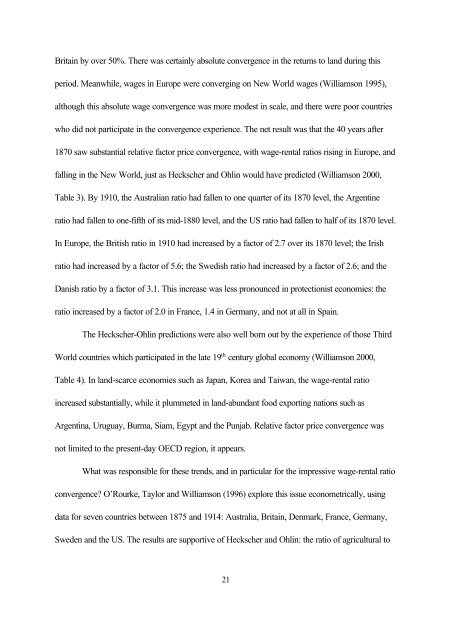Globalization and Inequality - Trinity College Dublin
Globalization and Inequality - Trinity College Dublin
Globalization and Inequality - Trinity College Dublin
Create successful ePaper yourself
Turn your PDF publications into a flip-book with our unique Google optimized e-Paper software.
Britain by over 50%. There was certainly absolute convergence in the returns to l<strong>and</strong> during this<br />
period. Meanwhile, wages in Europe were converging on New World wages (Williamson 1995),<br />
although this absolute wage convergence was more modest in scale, <strong>and</strong> there were poor countries<br />
who did not participate in the convergence experience. The net result was that the 40 years after<br />
1870 saw substantial relative factor price convergence, with wage-rental ratios rising in Europe, <strong>and</strong><br />
falling in the New World, just as Heckscher <strong>and</strong> Ohlin would have predicted (Williamson 2000,<br />
Table 3). By 1910, the Australian ratio had fallen to one quarter of its 1870 level, the Argentine<br />
ratio had fallen to one-fifth of its mid-1880 level, <strong>and</strong> the US ratio had fallen to half of its 1870 level.<br />
In Europe, the British ratio in 1910 had increased by a factor of 2.7 over its 1870 level; the Irish<br />
ratio had increased by a factor of 5.6; the Swedish ratio had increased by a factor of 2.6; <strong>and</strong> the<br />
Danish ratio by a factor of 3.1. This increase was less pronounced in protectionist economies: the<br />
ratio increased by a factor of 2.0 in France, 1.4 in Germany, <strong>and</strong> not at all in Spain.<br />
The Heckscher-Ohlin predictions were also well born out by the experience of those Third<br />
World countries which participated in the late 19 th century global economy (Williamson 2000,<br />
Table 4). In l<strong>and</strong>-scarce economies such as Japan, Korea <strong>and</strong> Taiwan, the wage-rental ratio<br />
increased substantially, while it plummeted in l<strong>and</strong>-abundant food exporting nations such as<br />
Argentina, Uruguay, Burma, Siam, Egypt <strong>and</strong> the Punjab. Relative factor price convergence was<br />
not limited to the present-day OECD region, it appears.<br />
What was responsible for these trends, <strong>and</strong> in particular for the impressive wage-rental ratio<br />
convergence? O’Rourke, Taylor <strong>and</strong> Williamson (1996) explore this issue econometrically, using<br />
data for seven countries between 1875 <strong>and</strong> 1914: Australia, Britain, Denmark, France, Germany,<br />
Sweden <strong>and</strong> the US. The results are supportive of Heckscher <strong>and</strong> Ohlin: the ratio of agricultural to<br />
21
















